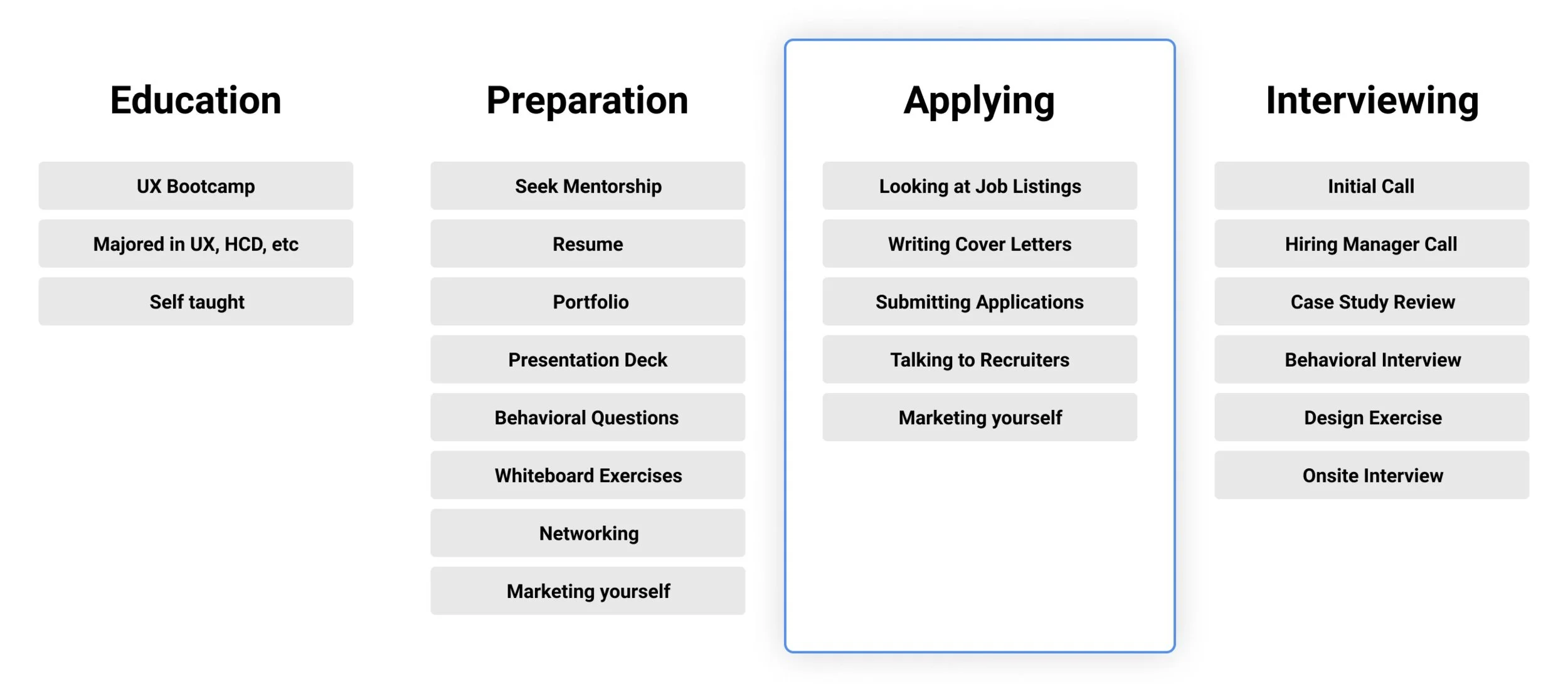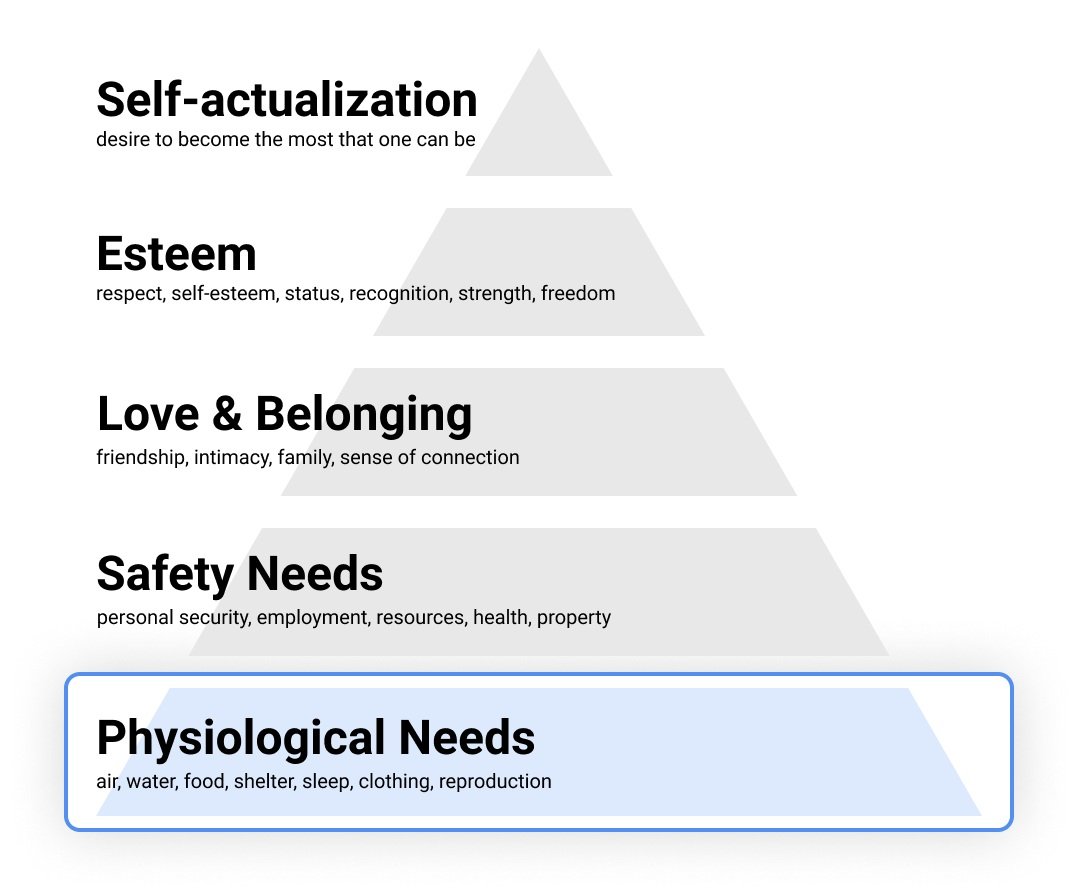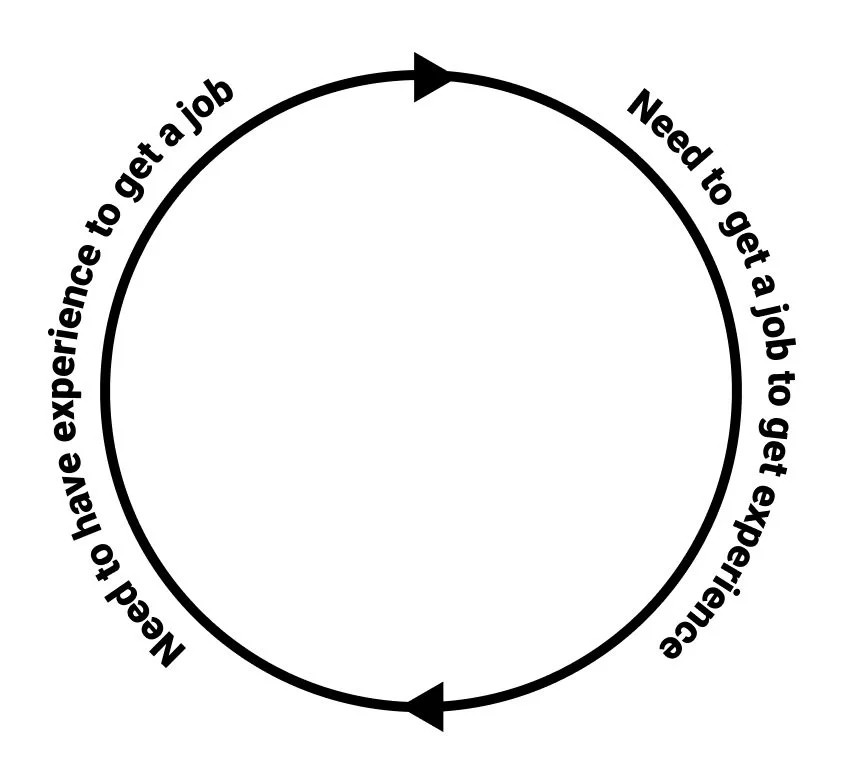The Art of Applying for UX Roles
This article is for…
This article is for anyone that is looking to “get their foot in the door” to the UX Design industry in the US. In my spare time, I speak with a lot of people looking to transition into UX, some with design backgrounds and some without. A common experience I hear is:
“I’ve applied for a bajillion-and-one jobs and I keep getting ghosted or rejected. ”
If you feel this way then this article is probably for you. I’ve diagrammed below where you should be in the preparation process to make the best use of this article. There are a lot of articles on how to put together a portfolio and interview tactics, but very few on the actual application process. Here’s some of my personal learnings.
This article is NOT for…
If you are someone that is looking to put food on the table or is in need of a stable income, then this article might not be helpful for you right now. Just like how hunger can cloud your judgment at the grocery store, desperation can impair decision-making when it comes to selecting the right role for you.
Do whatever you need to do to satisfy your immediate needs first before focusing on career progression. Breaking into an industry is not fast, nor is it easy and requires your full focus and attention. But if you can manage to dedicate 3 months to prepare without worrying about your baseline needs, then continue reading.
Maslow's Hierarchy of Needs
Evaluate your readiness
The first step to applying for jobs is assessing if you truly are ready to apply for jobs. This article assumes that you have done your due diligence and prepared for every step of the application process, from building a portfolio to mock-interviewing. The next step after that is evaluating the quality of the preparations you’ve done thus far. Think of it as a design assignment. Now that you’ve finished your designs, you have to critique them. I’ve created a small table to help you gauge your readiness to apply for UX roles. You could also reach out to other designers or mentors to have them evaluate your work.
Look in the right places
Many designers when looking for jobs will go to the most popular job boards. But the real question is “Are companies posting entry-level positions to the most popular job boards?” If you find yourself feeling like you’re stuck in a competency trap diagrammed to the left, then that might be an indication that you are looking for roles in the wrong places.
The problem with popularity is that it comes at a cost. What I mean by that is, only big companies have the $$$ to post jobs on these websites, but big companies also want candidates that can hit the ground running and can afford to only hire experienced candidates. Here’s an article detailing what might be the best places for entry-level positions. I’ll also link a robust list of job boards at the bottom of this article.
Conversely, working with a staffing agency could also be beneficial if you are entry level because they can help connect you to roles and companies that aren’t listed on job sites, or you connect you to resources you might not have knowledge of. More on this later.
Choose agencies over enterprises
Note* This section is only applicable to you if you don’t require a Visa to work (because contract roles typically don’t support Visas).
Many folks are attracted to the Amazon’s, Facebook’s, and Google’s and want to jump straight into these big organizations. After all, these are proven companies that have pioneered the tech industry, but therein lies the problem. Everyone wants to work for these companies as a direct hire. Consider instead joining smaller local agencies or taking contract roles through a staffing agency where there might be smaller candidate pools and more flexibility around qualifications.
Staffing agencies are great because the majority of them staff for big enterprise companies. An example of this is when someone goes on paternity leave and there is now a vacancy for x months. Well, they can’t hire someone to replace them, but they also can’t split the work internally because there’s too much of it. That’s when the staffing agency comes in.
Consultant agencies work in a similar way. Big companies reach out to consultant agencies when there is a limited scope of work that needs to be done, but there isn’t a business justification to hire a dedicated internal team. If you join a consultant agency, you can work with big-name companies, sample a lot of different projects, meet a lot of different teams, and observe different ways of working. If you are someone with only student projects in your portfolio, this can be a great way to get your foot in the door and build professional up a portfolio of professional case studies.
Trade equity for career capital
You may have heard the term total compensation at some point. This is important because in startups and enterprise roles, the majority of the pay you receive could be dependent on their stock performance. Because of this, you might see insane numbers because of stock appreciation. This is one of the reasons why many people want to pursue a career in enterprise design.
But consider taking a role at a company that doesn’t provide stock options. I’m not advising anyone to work for free or be underpaid. I am challenging you to consider that you may not have the skills or experience large enterprises are looking for right now. So in order to break into enterprise UX design, you’ll need to first have a proven track record of success and a way to develop those skills.
Organize your applications
The exercise of organizing companies and roles should help you better understand why you want to apply to a specific company, but also help identify what your current level of confidence is relative to the roles available on the market. Reach, safety, and match are three buckets you can use to organize the roles you apply to.
01 Reach
Reach is a role you think you can do if given the opportunity but is slightly outside of your current skill level.
02 Match
Match are roles that suit your current skill level and abilities.
03 Safety
Safety is a role that you are confident you can do and have done so in the past.
When applying, try to spread your applications across several weeks. For example, every month you could apply to 2 positions in your Reach bucket, 3 in your match, and 5 in your Safety. This allows for you to focus on the quality of your applications without burning through your Reach list in a day. Be judicious when applying for roles in your Reach bucket, because many large companies will have cooldown periods (such as Google) which limits the number of applications you can submit within a certain timeframe.
Track your application status
People are busy. I’ve got a million things going on at any given time, and I assume most people also have a million things they have going also. Sometimes that results in a delayed response or poor communication. Tracking an application can help remind you to follow up with people but also help you prioritize tasks that need to be done. Thankfully in 2021, there’s also a lot of software that can assist with this. Personally, I prefer using Miro or Trello to track what roles I have in the backlog and what are in progress.
Make lots of friends
Many designers only network and market themselves when they need a job. My advice is, don’t wait! Always build relationships. Reach out and connect to recruiters and designers, or engage in mentorship platforms. It is so much easier to ask for a favor from someone you have an established relationship with because the conversation doesn’t feel transactional. Pro tip: when asking for favors, be very specific with what you want, and always give someone an easy way to say no so it feels like a request and not a demand.
Write thoughtful letters
In a world where every company has a website and an online application form, it’s easy to forget that applying for a role is still heavily dependent on relationships. This is even more important in the post-pandemic age where we are all looking for more meaningful connections.
Writing a cover letter is a great way to make a first impression. It shows them that you care and will invest the time to do more than the bare minimum and that this role is important to you. It’s also a great opportunity to have more of your personality shine through. I assume in 2021, most people are also frequent receivers of spam. Your cover letter doesn’t need to be world class, it just needs to communicate that you’ve done research on the company and understand the value you can bring to them without sounding like spam. Be specific, thoughtful, and witty. Write to this recruiter as if you’re meeting a friend for the first time and you want them to know you’re a cool person to hang out with. If possible, try not to use a template and have each cover letter be unique and tailored to the role and company.
Sending thank you letters is also a good way to leave a lasting impression. Thank people for giving you the opportunity to learn and to share your experience. The letters should be short, simple, and concise. Thank you letters demonstrate that you’re respectful of others’ time, capable of empathizing with their needs, and shows you have initiative when it comes to professional correspondence.
Set expectations
The reality is breaking into any industry is hard. From what I’ve observed there is a large volume of designers that have 0-2 years of experience, but a lack of folks with 5-10 years of experience. This leads to the perception that UX designers are always in high demand, but also really difficult to actually land your first role.
In closing…
The application process can be exhausting, emotionally draining, and discouraging. But if approached correctly, the application process can also be a great learning opportunity. Continue growing and learning through the application process. Your goal (outside of getting the job) should be to learn something from each application whether it is about yourself, your work, or the hiring process. Best of luck.
Resources
Job Boards
Non-profit & sustainability
Remote work
Startups
https://www.builtinboston.com/ (you can replace ‘boston’ with any large US city)
Internships
Open Source Projects (Volunteer)
General
Relevant Links
Related to this article
Application Tracking CRM
Finding a mentor
Whiteboarding exercise
Networking
Compensation
Portfolio & resume inspiration







